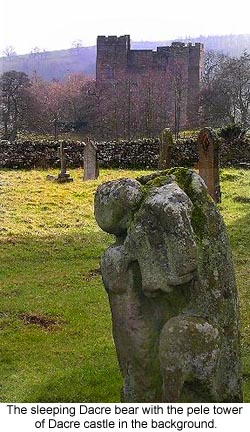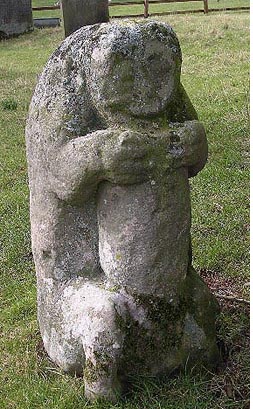The Mysterious Bears of Dacre
by Julia Hickey
Nestling on the edge of the Lake District, West of Penrith, is the tiny village of Dacre. As visitors enter the village, the most noticeable building is The Horse and Farrier, an eighteenth century coaching inn. Stop here for a pint of beer, home-cooked food and a warm welcome.
If you intend to explore, however, remember that parking at The Horse and Farrier is limited. Continue further down the hill or over the little humped bridge that crosses the Dacre Beck to find a spot to leave your vehicle.
 In early spring hosts of snowdrops line the water's edge. If the beck is a gentle trickle, it is possible to find shards of medieval pottery in the clear running water. Here you can enjoy the sunshine and be inspired in much the same way as the Wordsworths: both William and his sister Dorothy mention Dacre in their writings.
In early spring hosts of snowdrops line the water's edge. If the beck is a gentle trickle, it is possible to find shards of medieval pottery in the clear running water. Here you can enjoy the sunshine and be inspired in much the same way as the Wordsworths: both William and his sister Dorothy mention Dacre in their writings.
Dacre village has a long history. It was mentioned as early as AD 731 by the Venerable Bede in his Ecclesiastical History, and hosted the kings of Strathclyde, Scotland and England in the tenth century. Unfortunately the "Peace of Dacre" was not a lasting one and that meeting has faded into the mists of time. Nothing is left of the Saxon monastery where the three kings met, but the Norman church is built on or close to the site. It is also built with stone reclaimed from the monastery, which may in turn have been salvaged from a Roman site -- demonstrating that people have lived at Dacre for many thousands of years.
Before you explore the church, pause on your way up the hill to admire the fourteenth century pele tower with its crenellations. This tower was built by the Dacres in the fourteenth century to offer sanctuary from marauding Scots and itinerant reivers. The property is private; however, there are many different views from which it can be admired, including from the church.
Continue up the hill and turn right towards the church with its sturdy bell tower. The inside of St Andrew's offers a feeling of peacefulness and tranquillity, as well as some fine Norman architecture and an original 1617 Bible chained firmly to the wall and a lock donated by Lady Ann Clifford in 1671.
It is also home to two fascinating pieces of Viking masonry. The stones were found in 1900 when work was being done nearby. Both stones, badly damaged, are the remains of two separate stone crosses. The larger of the shafts shows carvings of people and animals, including a deer being chased by a dog. One of the figures at the bottom of the stone is wearing a skirt. Some believe she may be Eve offering the forbidden fruit to Adam. The smaller section of cross is more badly damaged, but one can still trace carvings of leaves intertwined with vines. Hiding n the middle of this rich foliage is a strange, long-necked creature with a sad face.
There is also a monument to a crusading knight. His legs are crossed, symbolising his journey to the Holy Land. He is probably a local baron, but his tomb has long since disappeared, as have his feet. Nearby a brass plate commemorates Jane Hassell, the daughter of Timothy Fethersthaugh, who was beheaded by the parliamentarians after the Battle of Worcester when the Royalist forces were defeated during the English Civil War.
 The loveliest window in the church is also one of the plainest. In the south wall of the chancel you will find a pair of windows designed and engraved by Lawrence Whistler. Framed with a quote from Milton, sunlight pours down onto the great house of Dalemain and the Lakeland mountains behind. The window's simplicity is breathtaking.
The loveliest window in the church is also one of the plainest. In the south wall of the chancel you will find a pair of windows designed and engraved by Lawrence Whistler. Framed with a quote from Milton, sunlight pours down onto the great house of Dalemain and the Lakeland mountains behind. The window's simplicity is breathtaking.
The most magnificent artefacts in Dacre Church aren't inside the building, however. In addition to the sundial, which uses an old alms table as its base, four very unusual creatures lurk in the graveyard. In each of the four corners stands a silent moss covered sentry: a stone bear. Each one of the four peculiar-looking bears is carved around a stone pillar and is supposed to tell part of a story.
The story starts in the Northwest corner. Here the bear is asleep with his paws wrapped round the pillar and his head resting gently on top of it. In the next two stones, the bear is attacked by, and fights with, a strange cat-like creature. In the final sculpture, the bear is alone once more. He has a distinct smile on his face, suggesting that he has eaten his attacker.
The idea that these creatures are bears was first recorded in 1704 when it was suggested that the carving were representative of the bear and ragged staff insignia used by the Earls of Warwick. Sadly for this theory, the bears in Dacre are rather older than the heraldic insignia used by the Earl of Warwick. The other problem is the bears themselves. Two of the stones are badly damaged, but the other two show that the bears have manes and long tails, suggesting that the Dacre bears are really lions.
In any event the bear mystery rounds off a visit to Dacre. The only thing left is to visit the Horse and Farrier for a pint of freshly pulled beer and to ponder who put the bears there and what they're trying to tell us.
More Information:
We regret that we no longer have the resources to maintain up-to-date links and/or hours and pricing details for the various sites and attractions listed on this website. For more information about the location(s) listed above, please use your favorite search engine or visit Wikipedia.
Julia Hickey is passionate about England's heritage and particularly of Cumbria, where her husband comes from. In between dragging her family around the country to a variety of historic monuments, she works part-time as a senior lecturer at Sheffield Hallam University. She spends the rest of her week writing. In her spare time, she enjoys walking, dabbling in family history, cross-stitch, tapestry and photography.
Article and photos © 2005 Julia Hickey
| 